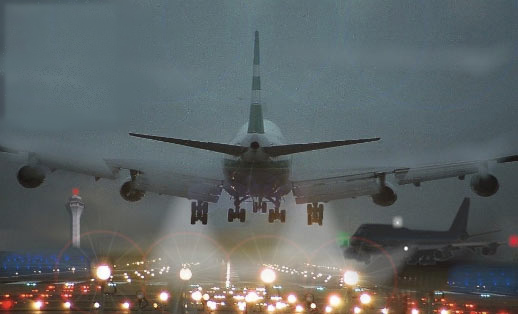 |
||||||||
| Issue Number 267 |
November
2001
|
|||||||
|
P.O. Box 189, Moffett Field, CA 94035-0189 |
||||||||
|
|
||||||||
 |
||||||||
| Issue Number 267 |
November
2001
|
|||||||
|
P.O. Box 189, Moffett Field, CA 94035-0189 |
||||||||
|
|
||||||||
"Hotspots" — On the Ground and in the Air
 Training
doesn't always keep pace with changes in aviation publications, as
two seasoned maintenance technicians discovered during taxi of an
aircraft from the maintenance base to the terminal at a major airport.
From the report filed with ASRS by the lead technician:
Training
doesn't always keep pace with changes in aviation publications, as
two seasoned maintenance technicians discovered during taxi of an
aircraft from the maintenance base to the terminal at a major airport.
From the report filed with ASRS by the lead technician:
Current commercial charts for this airport clearly show the runway incursion Hotspots as circled areas on the airport diagram. In a callback conversation with ASRS analysts, this reporter added that the runway incursion occurred at a poorly lighted taxiway and runway intersection. NOTAMS and updated airport charts had not been entered in the mandatory maintenance technicians reading file.
Right Spot, Bad Timing
When fuelers and maintenance technicians are servicing the same aircraft, positive communications are needed to safely coordinate the work. A B727 flight crew report to ASRS explains:
 Class
B Airspace
Class
B Airspace
A general aviation pilot discovered that recent FAA changes to VFR flight rules governing flight in Class B airspace outpaced the pilot's checking of NOTAMS:
Under newly revised Visual Flight Rules, aircraft with encoding transponders will be able to fly VFR in the Enhanced Class B airspace around designated major metropolitan areas. Pilots of aircraft with radio capability are instructed to monitor the guard frequency (121.5 MHz) while in Enhanced Class B airspace. Aircraft without transponders will be able to fly in Enhanced Class B if pilots first obtain a waiver.

Security Issues
 In
the wake of the September 11th terrorist activities, the security
of U.S. civil aviation passengers, aircraft, and airports has become
a national priority. Materials transported in the cargo holds of passenger-carrying
flights are related to these security concerns –- including hazardous
materials known as hazmat. Examples of hazmat include wheelchair
batteries, dry ice, corrosive materials, and containers of non-flammable
gas.
In
the wake of the September 11th terrorist activities, the security
of U.S. civil aviation passengers, aircraft, and airports has become
a national priority. Materials transported in the cargo holds of passenger-carrying
flights are related to these security concerns –- including hazardous
materials known as hazmat. Examples of hazmat include wheelchair
batteries, dry ice, corrosive materials, and containers of non-flammable
gas.
Airline dispatchers are required to provide specific load and weight-and-balance information to flight crews before flight, including the location of any hazmat. It is crucial to safe flight operations that load information be declared and accurate, as this is the only means the flight crew has of knowing what cargo is on board and where to find it.
An informal review of pre-September 11th ASRS hazmat reports revealed that most incidents had one or more of the following factors in common:
The following report excerpts illustrate the range of problems identified.
Undeclared Hazmat
Illegible Load Manifests
A DC-10 flight crew returned to their airport of origin when the source of a strong odor could not be identified inflight. After the aircraft was met by the rescue squad, the crew secured and exited the aircraft. But their problems were only beginning...
Lessons learned: Specialists who prepare load manifests need to make hazmat paperwork legible, and flight crews need to review this paperwork for legibility and content prior to flight.
Inaccurate Load Manifests
A B757 Captain reported another aircraft diversion incident to the ASRS due to an equipment overheat indication. Once the aircraft was safely on the ground, the flight crew made a chilling discovery:
Unsafe Handling of Hazmat
Transportation of dangerous goods by air requires proper packaging and rigorous adherence to safety requirements, especially in these times of heightened national security awareness.
| ASRS Recently Issued Alerts On... |
|---|
| MD87/90 horizontal stabilizer jackscrew maintenance |
| "Hold short" clearance incidents ata an Eastern Coast airport |
| Lack of protective containers for oxygen bottle shipments |
| Jet blast from aircraft between runways at a major airport |
| Frequency problems related to an ATC facility's outages |
| September 2001 Report Intake | |
|---|---|
| Air Carrier/Air Taxi Pilots |
1,719
|
| General Aviation Pilots |
619
|
| Controllers |
37
|
| Cabin/Mechanics/Military/Other |
139
|
| TOTAL |
2,514
|